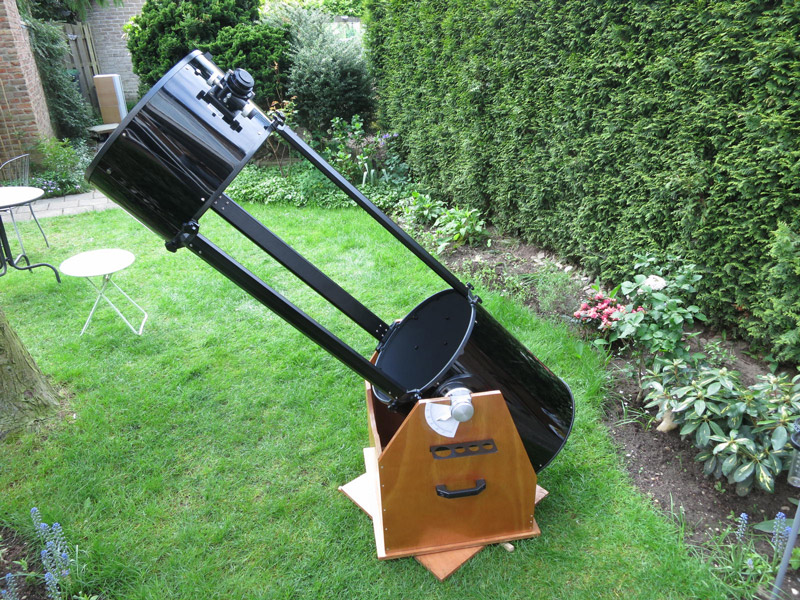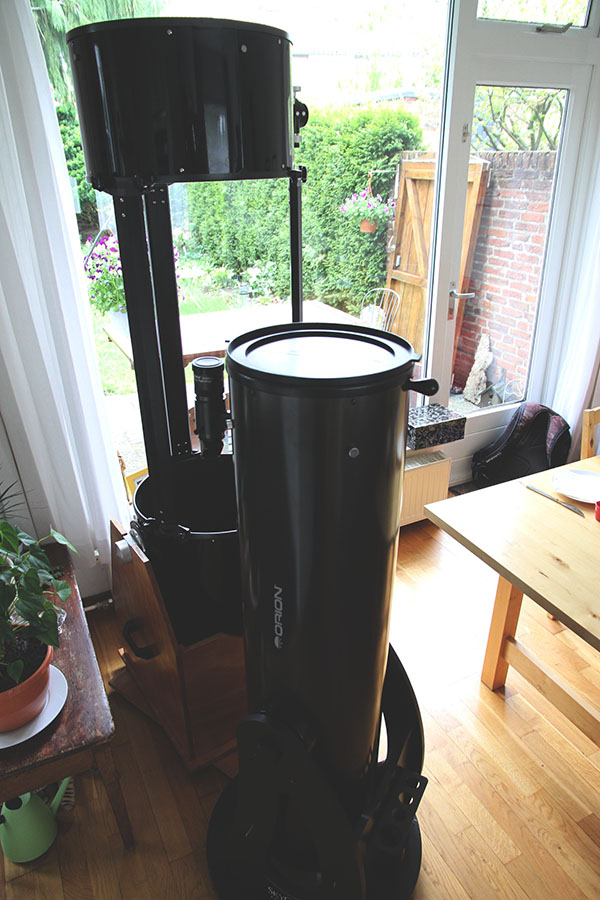- Index page with recent astrophotos
- Leeuwenboschfontein weekend starparty 2016 Mar 4-6
- Events observed by me from 2003 latest: Mercury transit 2016 May 9
- Page with sky pictures with the EOS 6
- Lunar and planetary images and phenomenas
- Page with sky pictures with the EOS 40 from Bali jan 2009, feb 2010 and 2012
- Page with sky pictures from La Palma Jan / Feb 2011
- Total lunar eclipse of 2011 Jun 15
- Solar eclipse visible as deep partial in Indonesia on 2009 Jan 26
- Old 1973 Polarex 80mm spotting scope refurbishment.
- New 2015 Robtics ED110 refractor
- Using a telephoto lens as a small handheld telescope
- Nice sky pictures taken from a plane in full flight
- How to see stars in the daytime ?
- Old astrophotos from 1980-1990s
- How I learned Astronomy
- Astronomik CLS filter test
- Simple Eclipse calculations
Dobson 400mm telescopeIn September 2009 I purchased from Astroshop an Orion XT-10 25cm Dobson and had lots of fun with it. But my aperture fever resulting in a lingering wish for a 40cm put me on scanning webshops for a reasonable 40cm. This size is just the largest size for a 'grab and go' as a telescope of such size (focal length 180cm) does not require ladders to reach the eyepiece and the scope is not too heavy. Although a cart on wheels can be extremely useful for the 65kg and even for a 25cm which still weight 27kg. A 25cm is 2 magnitudes brighter than a 10cm and a 40cm 3 magnitudes. On 17 Nay 2013 I found an offer on a Dutch astro trade mart for a 40cm f/4.5 Dobson with a GSO mirror. The owner had it enhanced with a smaller and lighter rocker box of plywood which has better quality than the original particle board. The focuser was replaced by a 1:10 focuser. So I went to Hengelo to inspect it and decided to buy it. It has a very smooth horizontal motion and the balance is adjustable.
| ||||||||||||
Pictures of the installation of the setting circlesLike the Orion XT-10, I installed azimuthal setting circles on it. | ||||||||||||
Pictures of the construction of the wheelcartAs this telescope + rocker box is too heavy to carry once (65kg) I decided to make a wheel cart which carries the handles on the sides of the box and can be moved on wheels with air pressure tyres. The all-plastic massive wheels induce too much vibration which causes decollimation during transport. So I purchased a wheel cart at a consumer building supply shop for only $30. And got a two 2m long steel tubes of 33mm x 2.65mm wall thickness for making the frame. I welded the frame of 60x60cm and attached it. Then I cut the wheel cart into two pieces. I welded the wheels part onto the frame which should embrace the box. Sorry, professional welders, the blobs do not show a good quality weld but strong enough to hold the weight. As on the rear (wheels side) it appeared that the nicely laquered box got damaged, I put an aluminum strip on it (over the scratches) to prevent this further.It has to be primed and painted yet, but it is ready to use and works conveniently. | ||||||||||||

